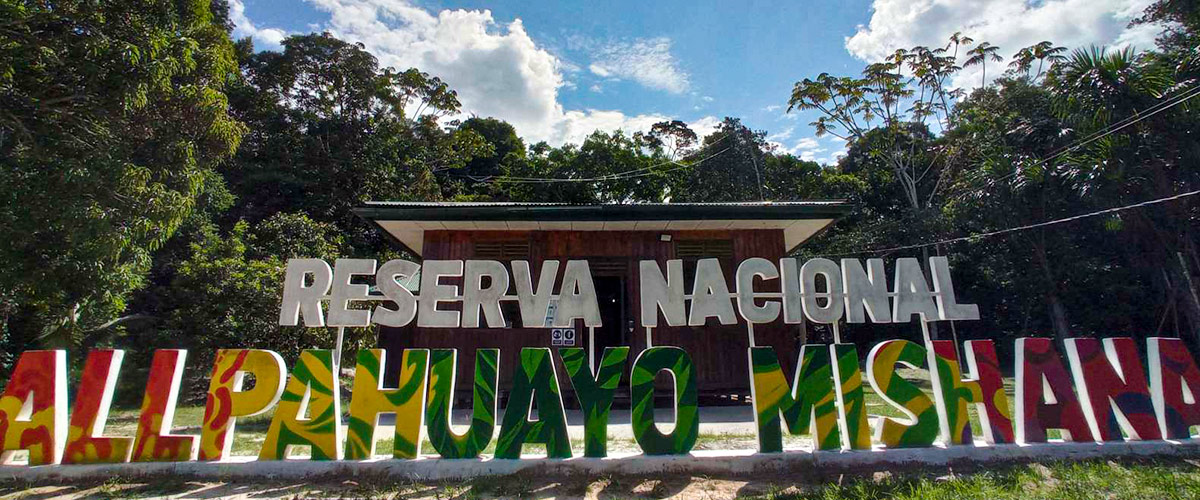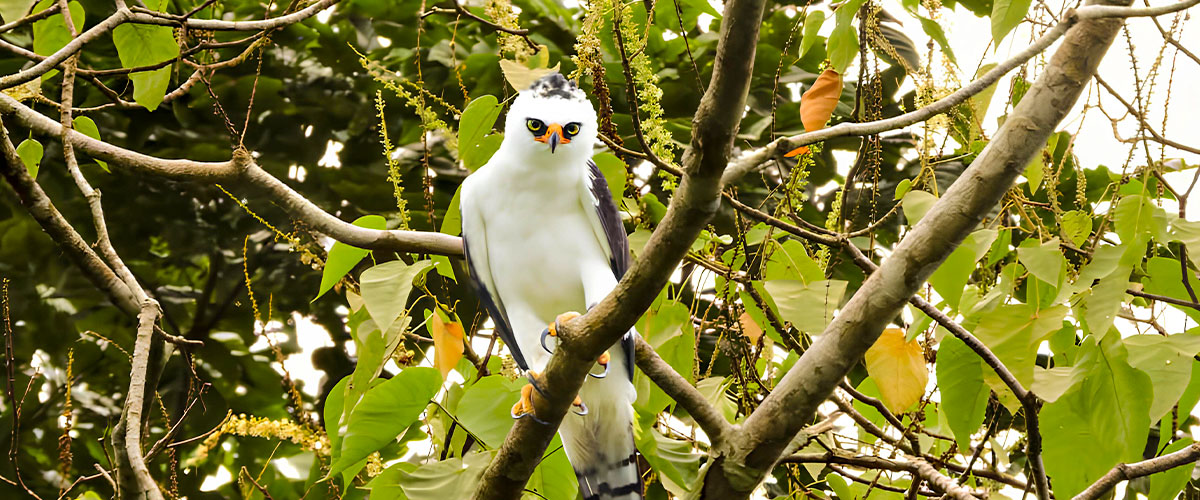The Allpahuayo Mishana National Reserve is establishing itself as an essential place for those who wish to explore the Peruvian Amazon. This protected area is home to the famous Iquitos Gnatcatcher, a biodiversity jewel that attracts wildlife observers and nature experts. Its access is easy and affordable, making it a perfect alternative for enjoying adventurous experiences among giant trees. In this place, visitors can go hiking, bird watching, or cycling, surrounded by Amazonian landscapes.
On the other hand, tourism has been one of the most important pillars for Allpahuayo Mishana, and in 2019, new routes were opened that expanded exploration possibilities, allowing visitors to discover corners previously reserved only for scientists and park rangers.
Although the pandemic temporarily interrupted these activities, the Allpahuayo Mishana National Reserve reopened its doors in 2021 with a renewed and attractive tourism proposal. Since then, they have strengthened collaborative work with local communities, who actively participate in conservation and in the development of experiences that include bicycle tours, sport fishing when water levels allow, and visits to hidden beaches during the low river season.
Additionally, there are special stops to observe river otters in the lakes hidden within the reserve, adding memorable moments for travelers. Every trail and every body of water in Allpahuayo Mishana witnesses exceptional biodiversity that sparks the interest of national and foreign tourists, turning this Amazonian destination into a place with many mysteries to discover.
About Allpahuayo Mishana National Reserve
The Allpahuayo Mishana National Reserve is a natural treasure that captivates with its unique landscapes and amazing biodiversity. It protects ecosystems as special as forests on white sands, known as "varillales" forests, and forests bathed by the black waters of the Nanay River. In the varillales, vegetation adapts to nutrient-poor soils and different drainage conditions, creating a unique environment where endemic species thrive.
Furthermore, in the flooded forests of Allpahuayo, unique flora and fauna are found, increasing its biological value; likewise, this area stands out for its potential for nature tourism and environmental education, and serves as a refuge for species such as the Iquitos gnatcatcher, a bird that only inhabits the varillales forests north of the reserve.
Key Facts about Allpahuayo Mishana
- Objective: To conserve the biological diversity and habitat of the "barral" and "chamizal" forests on white sand belonging to the Napo Ecoregion, as well as the floodable plain forests surrounding the Nanay River basin.
- Creation: It was established on January 15, 2004, by Supreme Decree No. 002-2004-AG.
- Location: It is located in the department of Loreto, Maynas province, very close to the city of Iquitos.
- Extension: It covers an area of 58,069.9 hectares.
- Climate: It has a warm and humid climate, with average temperatures between 26 °C and 28 °C and abundant rainfall throughout the year.
- Outstanding Biodiversity: It is a habitat for endemic and rare species, such as the Iquitos gnatcatcher and various unique plants from white sand soils. Additionally, it hosts more than 1,700 plant species and nearly 500 registered bird species.
- Hydrological Importance: It protects part of the water sources that supply Iquitos, ensuring ecological balance and the sustainable use of natural resources by local communities.
Where is Allpahuayo Mishana located?
The reserve is located 23 km south of Iquitos Peru, which facilitates visits and makes it an accessible place. Among its landscapes are places like Mishana, a community closely linked to the Allpahuayo Mishana National Reserve; furthermore, this protected area safeguards fundamental water sources for the supply of the city of Iquitos and guarantees the traditional use of renewable natural resources by the communities settled in the area.
Flora and fauna
The Allpahuayo Mishana National Reserve is home to an impressive biological diversity that makes it one of the most fascinating natural spaces in the Peruvian Amazon. Around 145 mammal species have been recorded, with two endemic species standing out: the equatorial saki (Pithecia aequatorialis) and a rodent still little studied, known as Scolomys melanops. The equatorial saki, along with the black titi monkey (Callicebus torquatus), are among the primates whose protection is concentrated in this place, given their very particular habitat.
In terms of birdlife, the reserve has about 475 bird species, of which 21 are exclusive to white sand forests and nine are endemic to the Napo Ecoregion. In addition, 83 species of amphibians have been identified, many of them unique to this ecoregion, along with 120 species of reptiles and 155 species of fish that inhabit its various bodies of water.
The plant richness is also outstanding, with endemic species such as the rodral aguaje (Mauritia carana), the rodal caimito (Pouteria sp.), the aguajillo (Mauritiella aculeata), the carachacaspi (Tachigalia sp.), the irapay (Lepidocaryum tenue) and the aceite de caspi (Caraipa tereticaulis), among others, many of which are adapted to grow in the peculiar white sand soils.
How to get to Allpahuayo Mishana?
Just 45 minutes from the Plaza de Armas in Iquitos is one of the most used land accesses to enter the Allpahuayo Mishana National Reserve. To get there on your own from Iquitos, you can take a vehicle at the terminal on Aguirre street, in front of the Sachachorro Shopping Center, which covers the Iquitos-Nauta route.
It is important to inform the driver that your destination is the reserve, so they will drop you off at kilometer 28 of the highway. The approximate cost of the ticket is 15 soles (about 3.9 dollars). Once there, you will find the Irapay control post, where you should contact one of the park rangers, who will provide you with guidance and necessary instructions to explore the area. To enter the protected area, a payment of 11 soles (approximately 2.8 dollars) must be made.
Tourist Routes in the Allpahuayo Mishana National Reserve
When exploring the Allpahuayo Mishana Reserve, you can discover a variety of routes that allow you to admire its surprising biodiversity and unique landscapes. Between kilometers 25 and 26 of the Iquitos-Nauta highway, there is a low humid forest, characterized by its stands, where it is possible to observe numerous bird species. Very close, at kilometer 25, there is a birdwatching tourist circuit within a wooded forest, accessible and close to the main road.
In the Nanay River sector, periodically flooded forests can be seen, an ecosystem full of scenic and biological richness. At kilometer 23 there is a livestock farm that allows you to learn about sustainable wildlife management practices, such as the capybara and the peccary. On the other hand, at kilometer 26 is the Allpahuayo Research Center (CIA), belonging to the Peruvian Amazon Research Institute (IIAP), where visitors can observe living collections of medicinal plants and native fruit trees. Finally, at kilometer 28 is the El Irapay surveillance post, the starting point of a trail that leads to the Mishana community, crossing various stands along the way.
A paradise for bird watching lovers
The Allpahuayo Mishana National Reserve protects ecosystems of great biological diversity such as rodal and chamizal forests on white sand, flooded black water forests, and species such as the Iquitos Perlita, a bird endemic to this area. In addition, there are 475 species of birds, 21 of which are exclusive to the white sand forests, so this reserve offers the ideal space for activities such as bird watching.
Space for scientific research
This reserve is a space for research and university education, in fact, this is where the majority of Iquiteños university students go when they need to do their internships, because they can learn about biodiversity, soils, forests, water, streams, among others. others.
Threats: mining and illegal logging
Its proximity to the city of Iquitos also makes it the target of many illegal activities that put at risk the resources that Allpahuayo Mishana houses and protects. For years there was a municipal dump in its buffer zone and the non-metallic mining (white sand) that takes place around the Iquitos-Nauta highway is a constant threat. Currently, the illegal mining with dredges that has been taking place in the Nanay basin and the deforestation for the illegal use of timber species used for firewood and charcoal have put the reserve management on alert.
Machu Picchu Travel Tours
Reserve our guided trips to Machu Picchu by contacting our travel experts and you will be closer to completing your adventure:
- Cusco Tours
- Machu Picchu Day Trip
- Sacred Valley to Machu Picchu
- Machu Picchu Peru
- Machu Picchu tours from Lima
- Inti Raymi Festival and Machu Picchu
- Combo Sacred Valley to Machu Picchu
- Book Inca Trail Tours 2025
If you want to visit Machu Picchu, we recommend you to book your Machu Picchu Ticket in advance, so you will enjoy your Vacation in Machu Picchu without any problem.
The best tours in the Amazon Rainforest
Exploring the Peruvian Amazon is entering a world full of wildlife, tropical forests, and communities that preserve traditions. Each tour allows you to discover surprising landscapes and coexist with nature, turning the trip into an unforgettable experience.
- Amazon Rainforest to Salkantay Trek
- Amazon and Machu Picchu Tour
- Inca Trekkers
- Peru Panorama
- Peru Hike and Amazon
- Peru Amazon and Lares Trek
- Peru Rainforest Tour
- The Manu Crudel of Life
- Manu Park Iosphere
- Jungle Trip Peru
- Manu Peru Amazon
- Manu Cusco Tour
- Manu Adventures Cusco
- Manu Extreme Biodiversity









